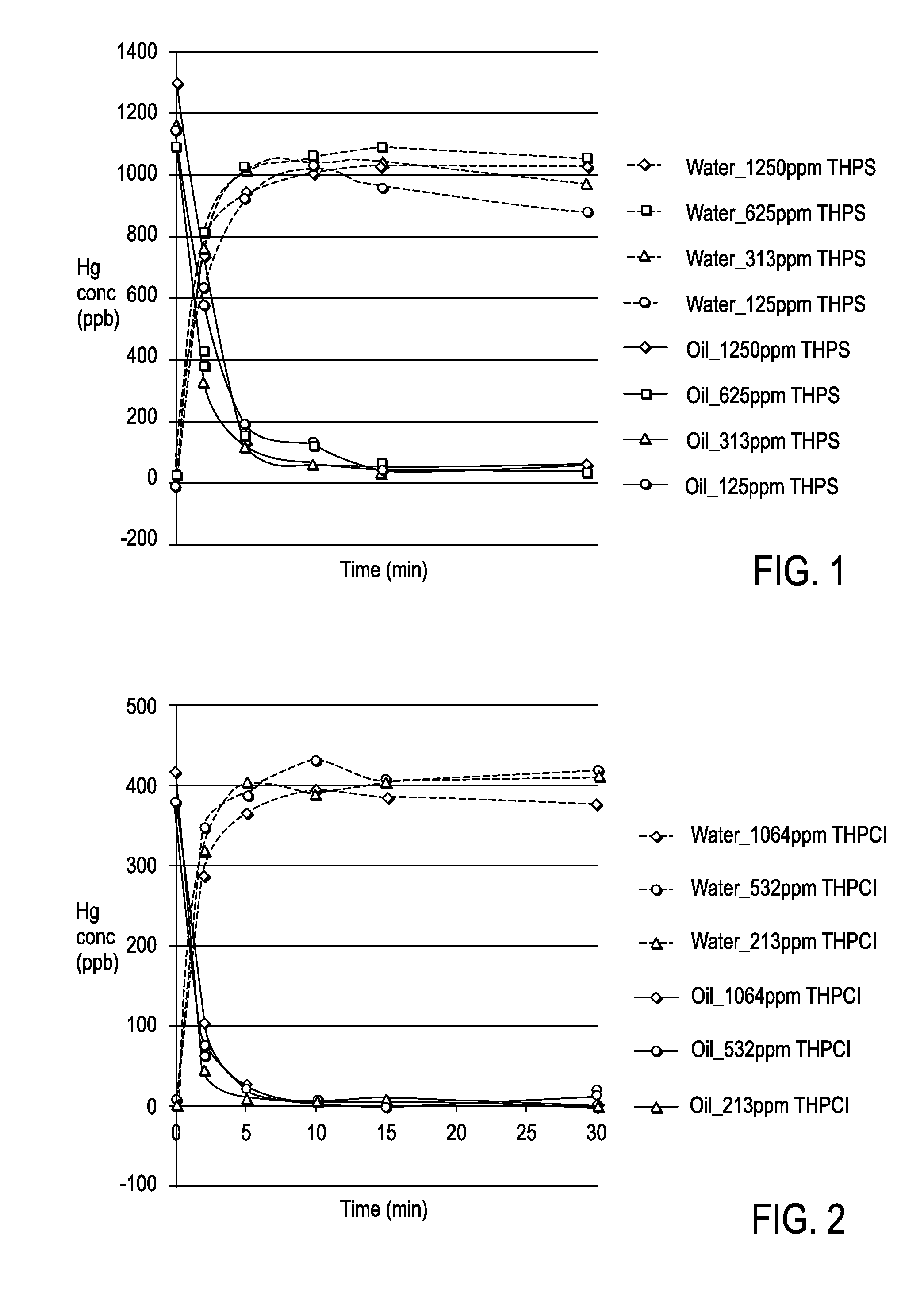Process, method, and system for removing heavy metals from fluids
a technology of heavy metals and fluids, applied in the field of heavy metal removal systems, can solve the problems of high cost and cumbersomeness of crude oil filtering, and achieve the effect of reducing mercury in crude oil and reducing or removing trace elements
- Summary
- Abstract
- Description
- Claims
- Application Information
AI Technical Summary
Benefits of technology
Problems solved by technology
Method used
Image
Examples
example 1
[0059]50 mL of mercury vapor feed preparation containing approximately 1,100 ppb Hg was added to a number of 100 mL glass tubes, then mercury level was measured using LUMEX mercury analyzer equipped with PYRO-915+. 50 mL of distilled water was placed in the tubes, and the mercury level was measured using LUMEX mercury analyzer equipped with PYRO-915+. A pre-determined volume of 3 different oxidants (hydrogen peroxide (H2O2), t-butyl hydroperoxide, and cumene hydroperoxide) was added to each reactor for a final oxidant concentration of 50 ppm. The oil-water mixture was stirred up for 1 minute. In the next step, different complexing reagents (potassium iodide (KI), sodium thiosulfate (Na2S2O3), TETREN, and Na4EDTA) were added to each reactor to make a final concentration of: 50, 500 and 5,000 ppm KI; 470 and 4,700 ppm Na2S2O3; 570 and 5,700 ppm TETREN; 1,200 and 12,000 ppm Na4EDTA. The tubes were shaken vigorously for 1 minute. Aliquots of both oil and water from each were analyzed fo...
example 2
[0061]50 mL of distilled water was placed in each of a number of 250 mL glass tubes, and the mercury level was measured using LUMEX mercury analyzer equipped with PYRO-915+. 50 mL of mercury vapor feed preparation containing approximately 400 ppb Hg was added to each of the glass tubes, then mercury level was measured using LUMEX mercury analyzer equipped with PYRO-915+. A pre-determined volume of hydrogen peroxide (0.3% H2O2) stock solution was added to each of the tubes at molar ratio of H2O2 to Hg of 246:1. The mixture was stirred up for 1 minute at 600 rpm. In the next step, different complexing reagents (potassium iodide (KI), sodium thiosulfate (Na2S2O3), TETREN, and Na4EDTA) were added to each tube at a molar ratio of complexing agent to mercury as 5,000:1. The tubes were agitated at 600 rpm. Aliquots of both oil and water from each tube at 2, 5, 10, 15, and 30 minute intervals and analyzed for mercury.
PUM
| Property | Measurement | Unit |
|---|---|---|
| molar ratio | aaaaa | aaaaa |
| molar ratio | aaaaa | aaaaa |
| molar ratio | aaaaa | aaaaa |
Abstract
Description
Claims
Application Information
 Login to View More
Login to View More - R&D
- Intellectual Property
- Life Sciences
- Materials
- Tech Scout
- Unparalleled Data Quality
- Higher Quality Content
- 60% Fewer Hallucinations
Browse by: Latest US Patents, China's latest patents, Technical Efficacy Thesaurus, Application Domain, Technology Topic, Popular Technical Reports.
© 2025 PatSnap. All rights reserved.Legal|Privacy policy|Modern Slavery Act Transparency Statement|Sitemap|About US| Contact US: help@patsnap.com

